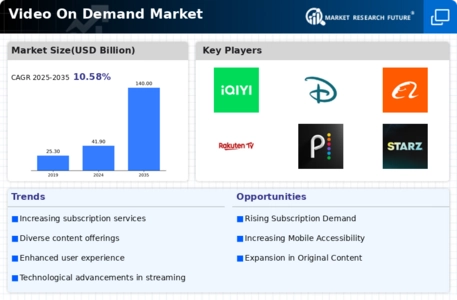Top Industry Leaders in the Video on Demand Market
Competitive Landscape of the Video on Demand (VOD) Market
The video on demand (VOD) market is a battleground where titans clash and smaller players nimbly dodge to carve out their niches. Let's delve into the landscape, examining key players, their go-to tactics, and emerging trends.
Key Players:
- Alphabet, Inc. (California, US)
- Hulu LLC (The Walt Disney Company) (California, US)
- AT&T, Inc. (Warner Media, LLC and Discovery, Inc.) (Texas, US)
- Netflix, Inc. (California, US)
- Apple, Inc. (California, US)
- Comcast Corporation (Philadelphia, US)
- Facebook, Inc. (California, US)
- Telefonaktiebolaget LM Ericsson (Stockholm, Sweden)
- Verizon Communications Inc. (New York, US)
Strategies for Survival:
- Content is King: The battle for eyeballs hinges on content. Originals like "Stranger Things" and "The Mandalorian" have become cultural phenomena, while licensed blockbusters and classic TV shows offer familiar comfort. Niche-focused platforms like Mubi and Shudder tap into specific viewer interests.
- Technology and User Experience: Smooth streaming, personalized recommendations, and innovative features like interactive content keep users engaged. Disney+ leverages its technological muscle for immersive viewing experiences, while Netflix refines its recommendation algorithms for optimal content discovery.
- Pricing and Bundling: Balancing affordability with profitability is crucial. Subscription tiers, discounted family plans, and bundling with other services like music and gaming attract cost-conscious consumers. Apple One bundles its various offerings, while Amazon Prime Video sweetens the deal with its Prime membership benefits.
- Global Ambitions: Reaching new markets fuels growth. Localization, subtitles, and dubbing content along with culturally relevant originals like Netflix's "Money Heist" open doors to international audiences. Disney+ expands its footprint with regional hubs like Disney+ Hotstar in India.
Market Share Analysis Factors:
- Subscriber Numbers: The raw metric of who has the most paying customers. Netflix's dominant lead is challenged by Disney+'s rapid growth.
- Content Quality and Depth: The breadth and originality of content libraries play a significant role. Netflix's diverse original slate competes with Disney+'s powerful franchises.
- Regional Penetration: Geographic reach and market share in key regions like Asia and Latin America matter. iQiyi dominates the Chinese market, while HBO Max eyes Latin America with its telenovela partnerships.
- Revenue and Profitability: Ultimately, financial performance determines long-term viability. While Netflix boasts high subscriber numbers, Disney+ is closing the gap in revenue generation.
New and Emerging Players:
- Ad-supported VOD platforms: Pluto TV, Roku Channel, and Tubi offer free, ad-supported content, attracting budget-conscious viewers and challenging traditional cable models.
- Short-form video platforms: TikTok and YouTube Shorts cater to the growing appetite for bite-sized content, potentially siphoning away viewers from longer-form formats.
- Gaming VOD platforms: Twitch and YouTube Gaming live-stream gameplay experiences, blurring the lines between traditional VOD and interactive entertainment.
Current Investment Trends:
- Mergers and Acquisitions: Consolidation is happening, with larger players looking to acquire smaller, niche platforms or content libraries. Disney's acquisition of Fox and AT&T's HBO Max merger are prime examples.
- Direct-to-consumer focus: Studios are launching their own platforms, bypassing traditional distributors and building direct relationships with audiences. Warner Bros. Discovery's HBO Max and NBCUniversal's Peacock exemplify this trend.
- Global expansion: Players are venturing into new territories, adapting content and marketing strategies to local preferences. Netflix's focus on international originals and Disney+'s regional hubs like Hotstar reflect this ambition.
Latest Company Updates:
January 21, 2024: Roku, the streaming device leader, acquired Nielsen's advanced TV advertising division, aiming to boost its targeted advertising capabilities.
January 19, 2024: AI-powered personalization rises: Several platforms, including Netflix and Hulu, are investing heavily in AI-powered recommendation algorithms to personalize content offerings and improve user engagement.
January 23, 2024: Free ad-supported VOD gains traction: Pluto TV, a free, ad-supported streaming platform, highlighting the increasing popularity of budget-friendly viewing options









